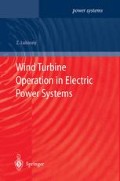Abstract
Modern wind turbine generator systems (WTGSs) are constructed mainly as systems with a horizontal axis of rotation, a wind wheel consisting of three blades, and high speed (1500/750 rpm) asynchronous generators and gear boxes (with ratio grater than 60); see Fig. 2.1. Asynchronous machines are used because of their advantages, such as simplicity of construction, possibilities of operation at various operational conditions, and low investment and operating costs. Asynchronous generators with squirrel-cage rotors and with wounded (slip-ring) rotors are used. In the second case, power electronic converters or variable resistors are connected to the rotor side of the machine, which makes it possible for the machine to operate at various speeds.1
Access this chapter
Tax calculation will be finalised at checkout
Purchases are for personal use only
Preview
Unable to display preview. Download preview PDF.
Reference
Unlike the WTGS with a squirrel-cage rotor asynchronous machine, which operates at constant speed (so-called constant speed system).
In fact, there is only one manufacturer of such a commercial WTGS.
Two-speed machine (constant speed system).
Variable-speed system.
Also the WTGS standstill can be considered as a state influencing the power system, e.g. by lack of electric energy production.
Please note that the figures show the WTGS power production measured for various wind conditions for each turbine. Therefore, the curves (e.g. amplitudes of power variations) cannot be directly compared. The curves should be treated here as typical for the given type of wind turbine only.
Overall costs, effectiveness and reliability of wind turbines are not considered or compared here.
The wind farm output power variations can be computed as -VTIZ1P, where zIP is the ith turbine output power variation and n is the number of wind turbines.
An MV voltage equal to 40 kV is given as an example here. Usually an MV voltage equal to 10–30 kV is used.
Author information
Authors and Affiliations
Rights and permissions
Copyright information
© 2003 Springer-Verlag Berlin Heidelberg
About this chapter
Cite this chapter
Lubosny, Z. (2003). Wind Turbine Generator Systems. In: Wind Turbine Operation in Electric Power Systems. Power Systems. Springer, Berlin, Heidelberg. https://doi.org/10.1007/978-3-662-10944-1_2
Download citation
DOI: https://doi.org/10.1007/978-3-662-10944-1_2
Publisher Name: Springer, Berlin, Heidelberg
Print ISBN: 978-3-642-07317-5
Online ISBN: 978-3-662-10944-1
eBook Packages: Springer Book Archive

